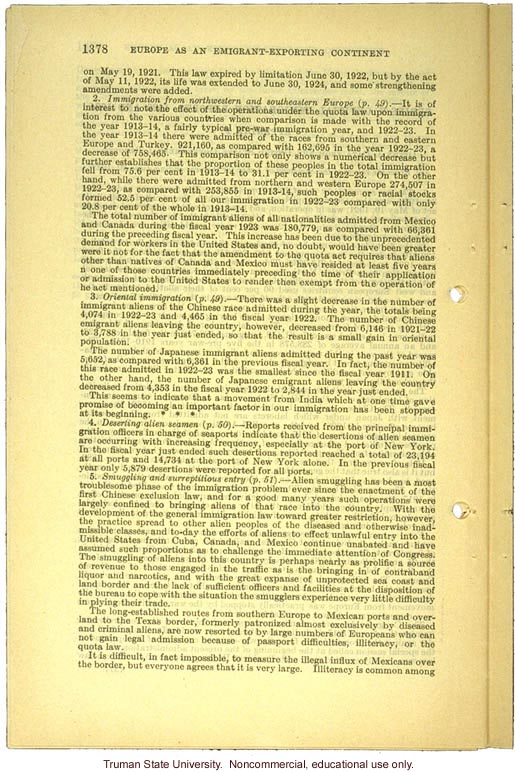"Europe as an emigrant-exporting continent," Harry H. Laughlin testimony before the House Committee, including Immigration Restriction Act (9)

"Europe as an emigrant-exporting continent," Harry H. Laughlin testimony before the House Committee, including Immigration Restriction Act (9)
1149. 1378 Europe as an Emigrant-Exporting Continent on May 19, 1921. This law expired by limitation June 30, 1922, but by the act of May 11, 1922, its life was extended to June 30, 1924, and some strengthening amendments were added. 2. Immigration from northwestern and southeastern Europe (p. 49). - It is of interest to not the effect of the operation under the quota law upon immigration from the various countries when comparison is made with the record of the year 1913-14, a fairly typical pre-war immigration year, and 1922-23. In the year 1913-14 there were admitted of the races from southern and eastern Europe and Turkey, 921,160, as compared with 162,695 in the year 1922-23, a decrease of 758,465. This comparison not only shows a numerical decrease but further establishes that the proportion of these peoples in the total immigration fell from 75.6 per cent in 1913-14 to 31.1 per cent in 1922-23. On the other hand, while there were admitted from northern and western Europe 274,507 in 1922-23, as compared with 253,855 in 1913-14, such peoples or racial stocks formed 52.5 per cent of all our immigration in 1922-23 compared with only 20.8 per cent of the whole in 1913-14. The total number of immigrants aliens of all nationalities admitted from Mexico and Canada diring the fiscal year 1923 was 180,779, as compared with 66,361 during the preceding fiscal year. This increase has been due to the unprecedented demand for worker in the United States and, no doubt, would have been greater were it not for the fact that the amendment to the quota act requires that aliens other than natives of Canada and Mexico must have resided at least five years in one of those countries immediately preceding the time of their application for admission to the United States to render them exempt from the operation of the act mentioned. 3. Oriental immigration (p. 49). - There was a slight decrease in the number of immigrant aliens of the Chinese race admitted during the year, the totals being 4,074 in 1922-23 and 4,465 in the fiscal year 1922. The number of Chinese emigrant aliens leaving the country, however, decreased from 6,146 in 1921-22 to 3,788 in the year just ended, so that the result is a small gain in oriental population. The number of Japanese immigrant aliens during the past year was 5,632, as compared with 6,361 in the previous fiscal year. In fact, the number of this race admitted in 1922-23 was the smallest since the fiscal year 1911. On the other hand, the number of Japanese emigrant aliens leaving the country decreased from 4,353 in the fiscal year 1922 to 2,844 in the year just ended. This seems to indicate that a movement from India which at one time gave promise of becoming an important factor in our immigration has been stopped at its beginning.*** 4. Deserting alien seamen. (p. 50). - Reports received from the principal immigration officers in charge of seaports indicate that the desertion of alien seamen are occurring with increasing frequency, especially at the port of New York. In the fiscal year just ended such desertions reported reached a total of 23,194 at all ports and 14, 734 at the port of New York alone. In the previous fiscal year only 5,879 desertions were reported for all ports. 5. Smuggling and surreptitious entry (p. 51). - Alien smuggling has been a most troublesome phase of the immigration problem ever since the enactment of the first Chinese exclusion law, and for a good many years such operations were largely confined to bringing aliens of that race into the country. With the development of the general immigration law toward greater restriction, however, the practice spread to other alien peoples of the diseased and otherwise inadmissible classes, and to-day the efforts of aliens to effect unlawful entry into the United States from Cuba, Canada, and Mexico continue unabated and have assumed such proportions as to challenge the immediate attention of Congress. The smuggling of aliens into this country is perhaps nearly as prolific a source of revenue to those engaged in the traffic as is the bringing in of contraband liquor and narcotics, and with the great expanse of unprotected sea coast and land border and the lack of sufficient officers and facilities at the disposition of the bureau to cope with the situation the smugglers experience very little difficulty in plying their trade. The long-established routes from southern Europe to Mexican ports and overland to the Texas border, formerly patronized almost exclusively by diseased and criminal aliens, are now resorted to by large numbers of Europeans who can not gain legal admission because of passport difficulties, illiteracy, or the quota law. It is difficult, in fact impossible, to measure the illegal influx of Mexicans over the border, but everyone agrees that it is very large. Illiteracy is common among
- ID: 11128
- Source: DNALC.EA


